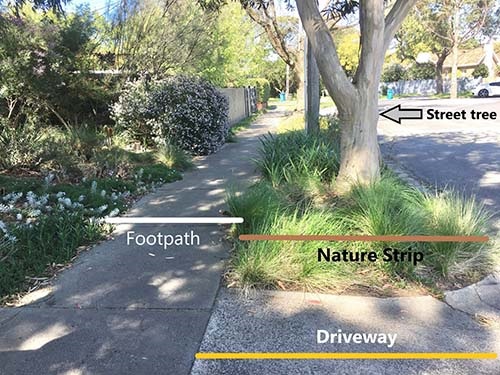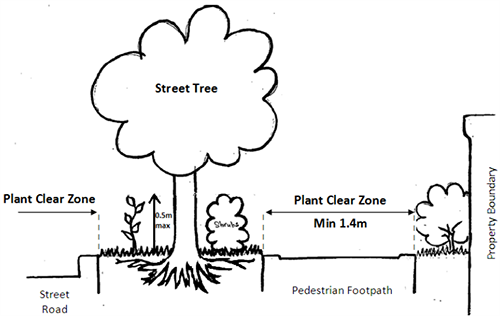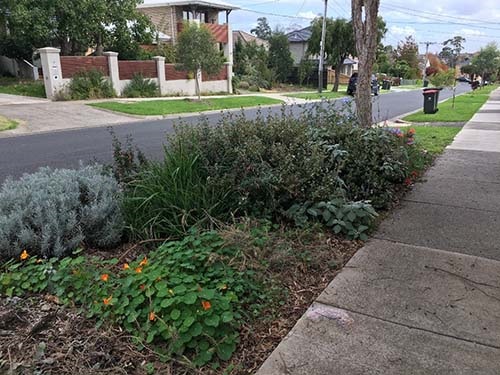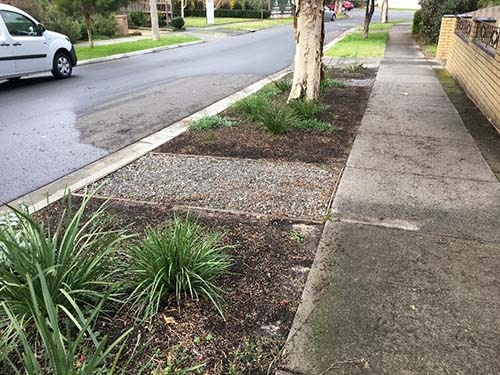A permit is required to undertake excavation and/or landscape works on nature strips.
Please read through the steps below before applying for your Planting on Nature Strip permit.
Planting on Nature Strips Guidelines
Information and permit application for planting on your residential nature strip
These guidelines provide Monash Council property owners with planting information and advice.
Learn about how to plant your nature strip with the below video:
What is a nature strip?
A nature strip is an area of public land between the property boundary and the kerb. It doesn’t include the footpath, kerb or driveway.

Nature strip role
Nature strips provide valuable green spaces in urban areas.
They often house essential services (such as communications, gas, water, sewerage, drainage and electricity) as well as an area for waste collection services.
Nature strips also allow easy access to the road or path, while providing vehicles and pedestrians with greater visibility, especially at corners or intersections.
Benefits of nature strips
Nature strips also provide various community and environmental benefits by:
- Absorbing rainwater, which improves the health of soil and reduces stormwater run-off into the street
- Helping to cool urban areas in the summer, as they do not reflect heat like pavements
- Providing shelter for people and wildlife, especially on hot days
- Providing green corridors for native wildlife, like birds and insects, which can be further encouraged by the use of indigenous plantings
- Improving the aesthetic quality of a street, which benefits property owners and businesses
Altogether, nature strips help to create a safer, more attractive and healthier environment for people to live and work in.
Keeping nature strips safe
When modifying nature strips, property owners must consider public safety and accessibility. Following Council's regulations and the recommendations below will minimise impact on other nature strip users and pedestrians.
Regulations for nature strip modification
Monash residents and property owners are allowed to modify nature strips, if:
- A permit has been obtained from Monash Council
- The footpath is not affected by modifications and meets Council’s standards for a typical footpath (min 1.4m)
- Plants, other than street trees, are no taller than 50cm
- The ground level of the nature strip (including soil and mulch) is not more than 4cm higher or lower than the footpath or kerb
- No permanent irrigation systems or private lighting systems are installed
- Any work on the nature strip is kept safe at all times for the community (more information below)
If you live on an arterial road you may not be able to plant on the nature strip. Please contact the Engineering Department at Council on 9518 3555 to discuss before you submit an application.

Creating community-friendly nature strips
Council assets, service infrastructure and street furniture on a nature strip must be visible and accessible. This includes fire hydrants, manholes, benches and poles. Service personnel must be able to safely enter and exit nature strips and properties when conducting works. If works do need to be completed, some plants may be taken out as part of the works. These plants will be replaced with topsoil and grass seeds.
It is important to remember that plantings should not get in the way of vehicles accessing properties or pedestrians accessing parked vehicles. There needs to be enough space on the nature strip for waste collection – rubbish, recycling and food and garden waste bins, as well as hard rubbish.
Preferred planting approach:
- Install a small garden edge around granitic sand or other permeable surfaces so it is not blown or washed away
- Ensure works on a nature strip do not affect the footpath, kerb or road
- Do not plant large trees or shrubs; street trees are Council’s responsibility
- Do not plant either poisonous or edible plants, including vegetables or fruits, for health and safety reasons
- Do not leave items on the nature strip which may be tripping hazards or projectiles
- Maintain your plantings so they remain under 50cm high and don’t grow over the kerb and footpath
Options for modifying a nature strip
Option 1: Replacing grass
The grass on a nature strip can be replaced without a permit from Council, but other modifications must go through the permit approval process. The best grasses for nature strips are indigenous or non-indigenous warm-season grasses, as they are more tolerant of drier conditions. Some indigenous examples include Weeping Grass and Kangaroo Grass.
Option 2: Approved Plantings
Property owners can mulch and plant nature strips, though this option may need more maintenance. It is best to use a natural, organic mulch around your plantings to create a good growing environment.
View our list of appropriate native and exotic species:Nature strips - suggested plants list(PDF, 2MB)

Option 3: Permeable Surfaces
Permeable materials such as granitic sand and mulch are useful ground coverings, as they let rainfall seep into the ground and require minimal maintenance other than occasional weeding. This option requires more material, labour and cost during installation. Excavation could be required to remove grass before installing the new surface.
A low garden edge should be installed to help prevent material being blown or washed away by the weather. Any garden edge used must match the levels of the adjacent nature strip area. Do not use edging next to the footpath or kerb, these will act as the edging. If it is found to be a tripping hazard, it will need to be removed. Any works must avoid damaging street trees and their root systems, and any underground services.
Note: Synthetic turf and hard paving, like concrete or bricks, cannot be used on nature strips as it stops water being absorbed into the ground. This increases flooding during high rainfall, increases surface temperatures on hot days and deprives street trees or other plants of water. It also impedes any necessary Council or other authority’s maintenance works on the nature strip.

Approval process for modifying a nature strip
Before you get started on planting your nature strip, read through this checklist so you are prepared for the application process.
- Tenants: Notify your property owner of your intention to modify the nature strip
- Call Dial Before You Dig (1100) to find out about any underground services in your nature strip
- Plan your nature strip planting by making a sketch of what it will look like from above, including the type of plants and a rough planting layout plan
- Remember to include any service or Council assets and allocated space for bin collection in your sketch
- Refer to the list of recommended plants(PDF, 2MB) and think about how much maintenance you want to do after planting
Please remember to sign up to the Nature Strip Planting Project, to receive free seedlings and garden supply vouchers.
Apply for Planting on Nature Strip Permit
When applying online, we will ask you for:
- The location of the nature strip (Property Search screen)
- Start and end of works
- Description of proposed works
- Sketch plan showing the location of the proposed landscaping and all assets within the nature strip assets affected by the works (trees, landscaping, road pavement, kerb and channel, footpaths, drains, service authority assets)
Apply online
- If you are friendly with your neighbours, you might want to let them know about what you are doing – they might even be inspired to plant on their own nature strip!
- After you have received your permit, you are ready to go.
Council has the authority to remove any plantings or works that impact on the safety of the public or public services. The landholder will be informed by Council first and have the opportunity to rectify the plantings, before Council initiates any rectification works.